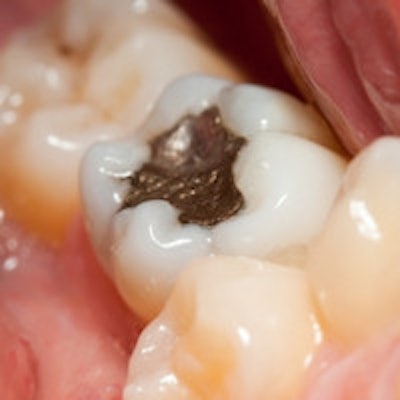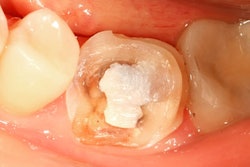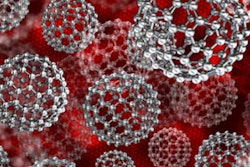
Nanomaterials that kill bacteria and remineralize teeth can be used to make better dental composites, according to a new study in ACS Applied Materials & Interfaces. The unique properties of nanomaterials can be incorporated into primers, adhesives, and composites to make them bioactive.
DrBicuspid.com spoke with researcher Mary Anne Melo, DDS, PhD, an assistant professor of operative dentistry at the University of Maryland School of Dentistry, to discuss her new study about using nanomaterials that can kill bacteria and remineralize teeth (ACS Appl Mater Interfaces, April 15, 2016).
DrBicuspid.com: What motivated this study?
 Mary Anne Melo, DDS, PhD, assistant professor of operative dentistry at the University of Maryland School of Dentistry. Image courtesy of University of Maryland School of Dentistry.
Mary Anne Melo, DDS, PhD, assistant professor of operative dentistry at the University of Maryland School of Dentistry. Image courtesy of University of Maryland School of Dentistry.Dr. Melo: Dental caries are still very prevalent among all ages worldwide. There have been many improvements in the treatment of caries, but there are still high rates of caries.
The problem is that most caries occur around restorations, especially around the margins of restoration -- secondary or recurrent caries. We noticed in clinical data that there are high rates of recurrent caries. This is a huge problem right now. Dentists spend 70% to 80% of their time replacing restorations; that's a lot of time to redo the procedure.
The majority of patients need to have their restorations replaced; it's pretty expensive to replace all those composite restorations.
What were your goals in the study?
We're trying to create a third function for dental materials in addition to appearance and strength. Now, dental materials are aesthetic -- they reproduce the tooth's appearance. They have a lot of strength to replace the missing parts of teeth, but they don't have bioactivity; there's no biological interaction. We hope to create a third function for dental materials -- to be bioactive, to kill bacterial/dental plaque that grows over the materials, and to remineralize tooth structure around the restoration.
“We hope to create a third function for dental materials—to be bioactive, to kill bacterial/dental plaque that grows over the materials, and to remineralize tooth structure around the restoration.”
What were the challenges?
Restorations are usually done using composites. They can be done with tooth-colored material, which most dentists use now, or silver fillings (dental amalgam). Tooth-colored fillings have very good properties and you can conserve more tissue when you do composite restorations.
We can conserve more tissue with composites, because you don't need to create retention; they're bonded to the tooth structure. However, you still have to deal with two big problems with composites. When we put in composite restorations, we need three materials: primer, adhesive, and the composite itself. The primer and adhesive are the two components that allow the composite to adhere to the tooth. The primer and adhesive together make up the adhesive system.
What are the problems with composites?
We have to deal with the biodegradation of the bonded interface. Imagine you have the composite, then you apply the adhesive to bond the composite to the tooth structure. Then you have an interface: the tooth, the adhesive in the middle, and the composite. But the interface made by the adhesive is weak and can be destroyed and dissolved by acid in bacteria. Also, composites tend to accumulate more biofilm/dental plaque, because it has a rougher surface than silver fillings or other filling materials.
Now we have two problems: degradation of the bonding interface, and the composite accumulates more plaque. Composites are easy targets when you have biofilm on restorations. We'll always have plaque on teeth, but sometimes it can accumulate too much on the composite, which produces acid that attacks the adhesive, which is especially susceptible to degradation by acid.
How did you overcome those obstacles?
We're trying to incorporate some agents in the composite, primer, and adhesive to create a new strategy to overcome the two problems of degradation and acid. We created a set of antibacterial and remineralization agents, because, first of all, I want to kill the bacteria in the plaque over the composite, and I want to avoid the acid in the interface. I don't want the bonded interface to be degraded by the acid.
We worked with nanotechnology-based agents. We used nanosilver as an antibacterial agent and some antibacterial monomers, because we can incorporate them into the composite. As a remineralizing agent, we used released acid neutralizer amorphous calcium phosphate nanoparticles (NACP). Now we have two agents to kill bacteria: nanosilver and nonreleased antibacterial macromolecules dimethylaminohexadecyl methacrylate (DMAHDM), an antibacterial monomer.
The agent NACP isn't an antibacterial; it releases ions of calcium and phosphate that help remineralize teeth. We use it because when you release a lot of calcium and phosphate, it neutralizes the acid from bacteria.
Now we have three materials that work in three different aspects, but all have the same goal: reduce plaque and bacteria over the material. We incorporated the three agents into a primer, an adhesive, and a composite. We wanted to see their mechanical behavior, because all these agents can work very well in isolation.
For example, nanosilver kills bacteria in isolation but not when it's incorporated with other materials. Materials can work well in the lab, but how will they behave in a filling and when patients bite on the restoration?
The oral environment is challenging -- saliva, chewing, and acid from food. We simulated those environments at the same time; we put biofilm/bacteria to grow over the material and analyzed the behavior of the interface after it was fatigued through stresses such as chewing.
What were the results?
The behavior was pretty good for the materials that have the three agents: primer, adhesive, and composite. Compared with controls -- regular primer, adhesive, and composites that are used in most patients now -- the results are very promising. We can simulate what happens in a clinical scenario -- patients biting on their restorations, including the primer, adhesive, and restoration.
It's challenging to move the development of new dental materials from benchtop research to clinical relevance, to see how it works in clinical human trials.
What's next?
Everybody wants to know, "So when can we use this?" Unfortunately we have to overcome a lot of other challenges, including the biocapability of the materials. We need to guarantee that they're 100% safe to use in humans. Now we need to validate the process and run clinical trials. Nanosilver and nano NACP have better performance because they're nanosized. They release a lot more calcium and phosphate because they're on a nanoscale. Nanosilver releases more ions because it's on a nanoscale. Because nano particles are very, very small, they have different properties. Tiny particles can have greater surface area, which allows you to do a lot of things. We are very happy with the results, because now we can see it will bring clinical relevance to our results.



















